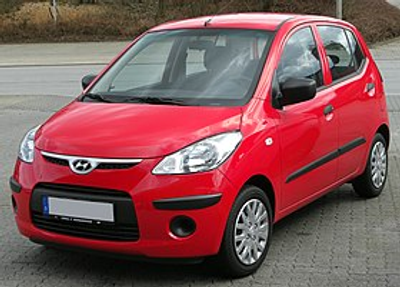

Used Hyundai i10 for Sale in Portugal
Found 74 cars
From €3 500 to €19 900
€11 206 (average)
Discover a wide selection of used Hyundai i10 cars for sale in Portugal. Browse through our listings to find your ideal compact vehicle, offering great fuel efficiency and city-friendly features at competitive prices.
2010 - 2013
The Hyundai i10 Generation 1, facelifted in 2010, marked a significant upgrade to this popular subcompact car. This model, which was initially launched in 2007, gained a fresh new look a...
Hatchback
1.1 AT (69 hp)
1.1 MT (69 hp)
1.2 AT (78 hp)
1.2 MT (78 hp)
| Name | Value | Unit |
|---|---|---|
| Acceleration (0-100 km/h) | 17.1 | s |
| Back suspension | Independent, Multi wishbone, spring, Stabilizer bar | |
| Body type | Hatchback | |
| Capacity | 1086 | cm3 |
| City driving fuel consumption per 100 km | 7.2 | l |
| Cruising range | from 490 to 710 | km |
| Curb weight | 935 | kg |
| Cylinder bore | 67 | mm |
| Cylinder layout | Inline | |
| Drive wheels | Front wheel drive | |
| Emission standards | EURO IV | |
| Engine power | 69 | hp |
| Engine type | Gasoline | |
| Front brakes | ventilated disc | |
| Front suspension | Independent, McPherson Struts, spring, Stabilizer bar | |
| Front track | 1400 | mm |
| Fuel | 92 | |
| Fuel tank capacity | 35 | l |
| Full weight | 1430 | kg |
| Gearbox type | Automatic | |
| Ground clearance | 149 | mm |
| Height | 1540 | mm |
| Highway driving fuel consumption per 100 km | 4.9 | l |
| Injection type | Multi-point fuel injection | |
| Length | 3585 | mm |
| Maximum torque | 99 | N*m |
| Max power at RPM | to 5 500 | RPM |
| Max speed | 149 | km/h |
| Max trunk capacity | 910 | l |
| Min trunk capacity | 225 | l |
| Mixed driving fuel consumption per 100 km | 5.8 | l |
| Number of cylinders | 4 | |
| Number of gear | 4 | |
| Number of seater | 5 | |
| Payload | 495 | kg |
| Presence of intercooler | Present | |
| Rear brakes | drum | |
| Rear track | 1385 | mm |
| Stroke cycle | 77 | mm |
| Trailer load (with brakes) | 2105 | kg |
| Turning circle | 9.5 | m |
| Turnover of maximum torque | to 4 500 | RPM |
| Valves per cylinder | 3 | |
| Wheelbase | 2380 | mm |
| Width | 1595 | mm |
